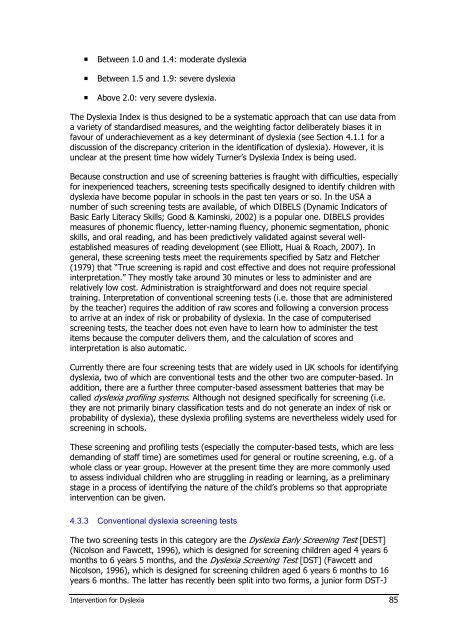Intervention for Dyslexia - The British Dyslexia Association
Intervention for Dyslexia - The British Dyslexia Association
Intervention for Dyslexia - The British Dyslexia Association
You also want an ePaper? Increase the reach of your titles
YUMPU automatically turns print PDFs into web optimized ePapers that Google loves.
Between 1.0 and 1.4: moderate dyslexia<br />
Between 1.5 and 1.9: severe dyslexia<br />
Above 2.0: very severe dyslexia.<br />
<strong>The</strong> <strong>Dyslexia</strong> Index is thus designed to be a systematic approach that can use data from<br />
a variety of standardised measures, and the weighting factor deliberately biases it in<br />
favour of underachievement as a key determinant of dyslexia (see Section 4.1.1 <strong>for</strong> a<br />
discussion of the discrepancy criterion in the identification of dyslexia). However, it is<br />
unclear at the present time how widely Turner’s <strong>Dyslexia</strong> Index is being used.<br />
Because construction and use of screening batteries is fraught with difficulties, especially<br />
<strong>for</strong> inexperienced teachers, screening tests specifically designed to identify children with<br />
dyslexia have become popular in schools in the past ten years or so. In the USA a<br />
number of such screening tests are available, of which DIBELS (Dynamic Indicators of<br />
Basic Early Literacy Skills; Good & Kaminski, 2002) is a popular one. DIBELS provides<br />
measures of phonemic fluency, letter-naming fluency, phonemic segmentation, phonic<br />
skills, and oral reading, and has been predictively validated against several wellestablished<br />
measures of reading development (see Elliott, Huai & Roach, 2007). In<br />
general, these screening tests meet the requirements specified by Satz and Fletcher<br />
(1979) that “True screening is rapid and cost effective and does not require professional<br />
interpretation.” <strong>The</strong>y mostly take around 30 minutes or less to administer and are<br />
relatively low cost. Administration is straight<strong>for</strong>ward and does not require special<br />
training. Interpretation of conventional screening tests (i.e. those that are administered<br />
by the teacher) requires the addition of raw scores and following a conversion process<br />
to arrive at an index of risk or probability of dyslexia. In the case of computerised<br />
screening tests, the teacher does not even have to learn how to administer the test<br />
items because the computer delivers them, and the calculation of scores and<br />
interpretation is also automatic.<br />
Currently there are four screening tests that are widely used in UK schools <strong>for</strong> identifying<br />
dyslexia, two of which are conventional tests and the other two are computer-based. In<br />
addition, there are a further three computer-based assessment batteries that may be<br />
called dyslexia profiling systems. Although not designed specifically <strong>for</strong> screening (i.e.<br />
they are not primarily binary classification tests and do not generate an index of risk or<br />
probability of dyslexia), these dyslexia profiling systems are nevertheless widely used <strong>for</strong><br />
screening in schools.<br />
<strong>The</strong>se screening and profiling tests (especially the computer-based tests, which are less<br />
demanding of staff time) are sometimes used <strong>for</strong> general or routine screening, e.g. of a<br />
whole class or year group. However at the present time they are more commonly used<br />
to assess individual children who are struggling in reading or learning, as a preliminary<br />
stage in a process of identifying the nature of the child’s problems so that appropriate<br />
intervention can be given.<br />
4.3.3 Conventional dyslexia screening tests<br />
<strong>The</strong> two screening tests in this category are the <strong>Dyslexia</strong> Early Screening Test [DEST]<br />
(Nicolson and Fawcett, 1996), which is designed <strong>for</strong> screening children aged 4 years 6<br />
months to 6 years 5 months, and the <strong>Dyslexia</strong> Screening Test [DST] (Fawcett and<br />
Nicolson, 1996), which is designed <strong>for</strong> screening children aged 6 years 6 months to 16<br />
years 6 months. <strong>The</strong> latter has recently been split into two <strong>for</strong>ms, a junior <strong>for</strong>m DST-J<br />
<strong>Intervention</strong> <strong>for</strong> <strong>Dyslexia</strong> 85









